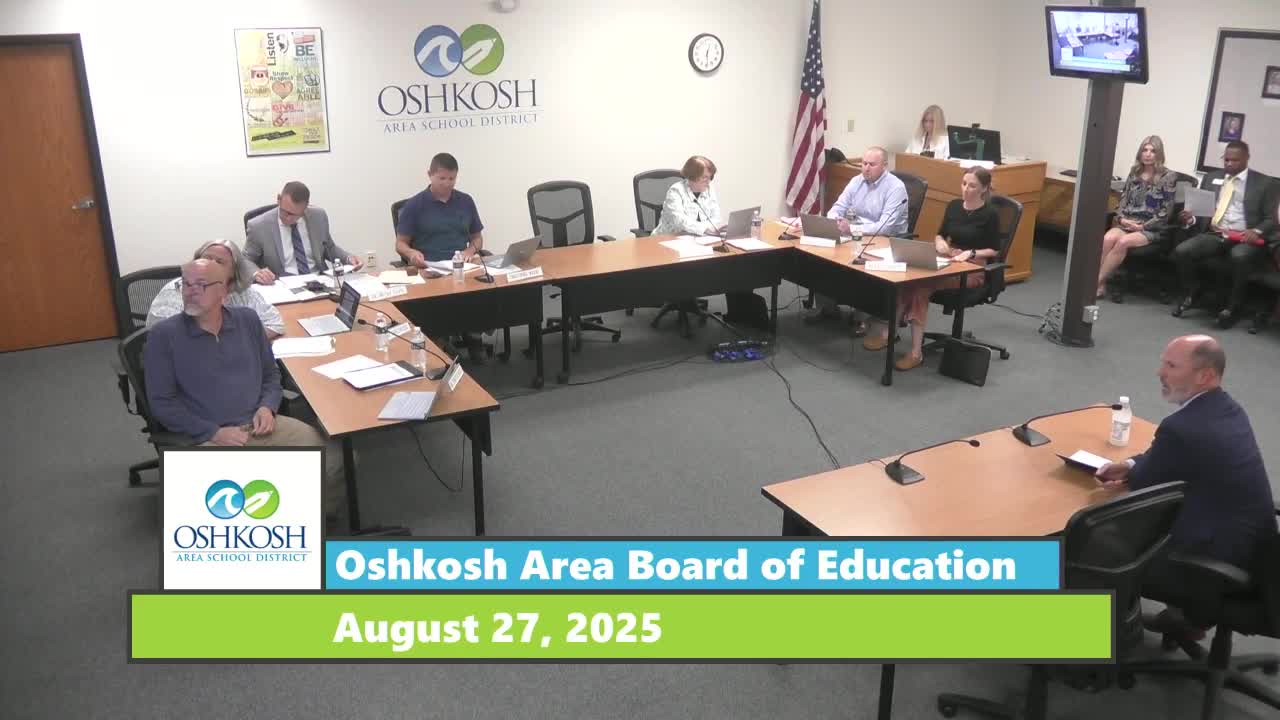Finance Committee reviews budget impact on taxes and funding for special education programs
August 28, 2025 | Oshkosh Area School District, School Districts, Wisconsin
This article was created by AI summarizing key points discussed. AI makes mistakes, so for full details and context, please refer to the video of the full meeting. Please report any errors so we can fix them. Report an error »

In a recent meeting of the Oshkosh Area Board of Education, key financial discussions unfolded, shedding light on the district's budgetary expectations and their implications for local taxpayers. As the board reviewed the upcoming fiscal year, the focus was on how state aid, property values, and enrollment figures would shape the financial landscape.
The meeting began with a presentation outlining the district's anticipated revenue and expenditures. Officials noted that while the overall funds may not balance perfectly, significant changes were expected, particularly in the capital projects fund, which recently received a substantial bond of nearly $80 million. This influx is projected to create a sizable surplus, providing a cushion as the district navigates its budget cycle.
A critical point of discussion was the general fund, which is primarily supported by state resources. The board anticipates a nearly $5 million increase in state aid, although this figure may be adjusted once state-certified numbers are released in October. This fluctuation could lead to an increase in property taxes, as the relationship between state aid and local taxes is inversely proportional—when one rises, the other tends to fall.
The board also highlighted the importance of special education funding, revealing a significant transfer from the general fund to the special education fund, which is expected to decrease due to increased state reimbursements. This change reflects a broader trend of enhanced support for special education, with state reimbursements rising from 30% to 42%.
As the meeting progressed, the board addressed the community service fund, which supports various recreational programs. The breakdown of expenditures revealed that a large portion of the $3.4 million budget is dedicated to community programming, emphasizing the district's commitment to serving local families.
The discussion culminated in a detailed analysis of the tax levy, which is projected to exceed $68 million. The anticipated mill rate is expected to decrease slightly to 7.86 cents, down from 7.9 cents the previous year. However, officials cautioned that individual tax bills may still rise due to increased property values, particularly for homeowners who have made improvements or purchased new homes.
In conclusion, the meeting underscored the complexities of school funding and the delicate balance between state aid and local taxes. As the district prepares for the upcoming fiscal year, the board remains committed to transparency and community engagement, ensuring that taxpayers are informed about how these financial decisions will impact them. With state aid numbers still pending, the board will continue to refine its budget in the coming months, aiming to provide quality education while managing fiscal responsibility.
The meeting began with a presentation outlining the district's anticipated revenue and expenditures. Officials noted that while the overall funds may not balance perfectly, significant changes were expected, particularly in the capital projects fund, which recently received a substantial bond of nearly $80 million. This influx is projected to create a sizable surplus, providing a cushion as the district navigates its budget cycle.
A critical point of discussion was the general fund, which is primarily supported by state resources. The board anticipates a nearly $5 million increase in state aid, although this figure may be adjusted once state-certified numbers are released in October. This fluctuation could lead to an increase in property taxes, as the relationship between state aid and local taxes is inversely proportional—when one rises, the other tends to fall.
The board also highlighted the importance of special education funding, revealing a significant transfer from the general fund to the special education fund, which is expected to decrease due to increased state reimbursements. This change reflects a broader trend of enhanced support for special education, with state reimbursements rising from 30% to 42%.
As the meeting progressed, the board addressed the community service fund, which supports various recreational programs. The breakdown of expenditures revealed that a large portion of the $3.4 million budget is dedicated to community programming, emphasizing the district's commitment to serving local families.
The discussion culminated in a detailed analysis of the tax levy, which is projected to exceed $68 million. The anticipated mill rate is expected to decrease slightly to 7.86 cents, down from 7.9 cents the previous year. However, officials cautioned that individual tax bills may still rise due to increased property values, particularly for homeowners who have made improvements or purchased new homes.
In conclusion, the meeting underscored the complexities of school funding and the delicate balance between state aid and local taxes. As the district prepares for the upcoming fiscal year, the board remains committed to transparency and community engagement, ensuring that taxpayers are informed about how these financial decisions will impact them. With state aid numbers still pending, the board will continue to refine its budget in the coming months, aiming to provide quality education while managing fiscal responsibility.
View full meeting
This article is based on a recent meeting—watch the full video and explore the complete transcript for deeper insights into the discussion.
View full meeting
